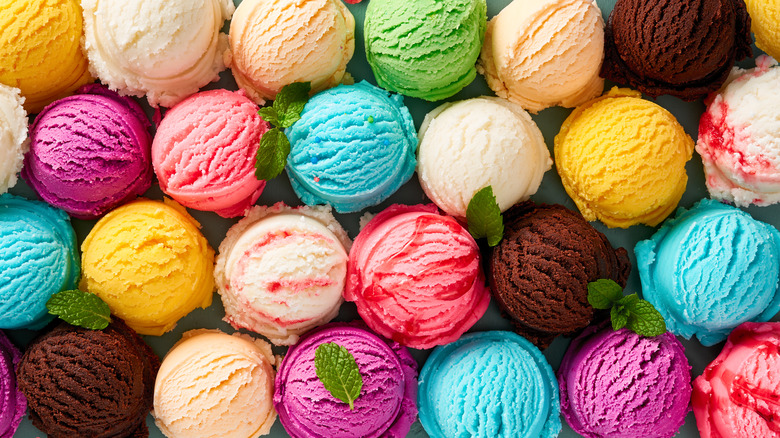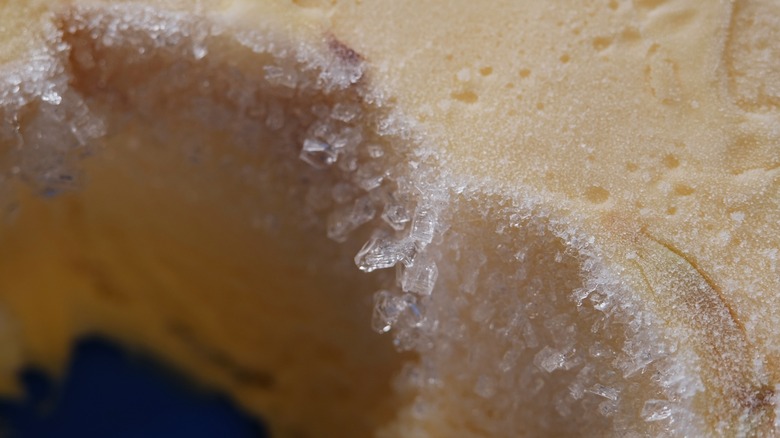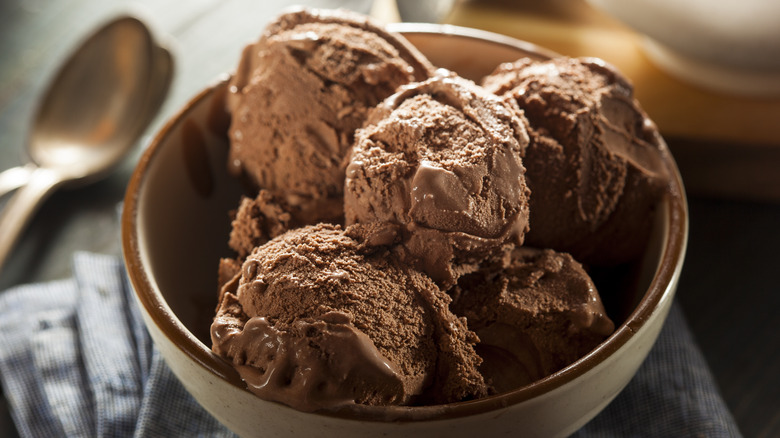Stop Freezer Burnt Ice Cream With A One-Step Hack
Ice cream is the perfect dessert — smooth or chunky, chocolatey or fruity, bold or subtle, it satisfies most cravings. But, one thing ice cream should never be is covered in freezer burn. The only thing worse might be a fully melted pint of ice cream soup, but a super frozen, ice crystal-covered carton of your favorite ice cream brand will leave you suffering through eating the weirdly crunchy abomination while wondering what could have been.
This tragedy happens when the ice cream is exposed to air, and it just as simply can be avoided if you minimize the time ice cream spends outside of the freezer. So, while it does feel good to wrap yourself up like a human burrito in a blanket and plop down on the couch with your favorite pint, you are ruining your ice cream for later — unless you plan to finish the pint in one sitting.
Otherwise, your best bet is to scoop the ice cream into a bowl. And here's the true hack: Use the rounded side of your spoon to smooth out the top layer of ice cream left in the container, and return it to the freezer ASAP. By doing this, you are decreasing how much surface of the ice cream is being exposed to the air and ensuring a pleasant experience for future scoops.
The lid of the container may also be the problem
Even if you followed the tip above and were lightning fast while you scooped out the ice cream, smoothed out the top, and then popped the pint back in the freezer, you may still see ice crystals the next time you open the container. But, it's for a totally different reason. Ice crystals can also form when liquid present on the treat (when it melts) starts to evaporate and then refreezes.
This is likely because the lid of the ice cream wasn't secured properly and air was able to sneak in. If your lid is damaged, punctured, or not super tight-fitting, press a small piece of plastic wrap, parchment paper, or wax paper directly on the top of the ice cream before putting the lid back on.
Then, you'll want to store ice cream at the back of the freezer instead of towards the front or on the flap of the door. Those areas are the warmest parts and most exposed to air when you open the freezer door, so melting and freezer burn are more likely. Also, take care of your delicacy on the ride home from the supermarket (and make sure it's the last food you buy at the grocery store). Sse an insulated bag, or shove the containers of ice cream by your feet in the car and blast the air conditioning vents towards it to keep it cold.
The ice creams least likely to get freezer burn
Ice cream brands with a higher water content and more air are the most likely to develop freezer burn. That means, if you prefer a fluffy and light texture, you are going to have to take extra care to ensure as little melting and air exposure as possible. If an ice cream flavor you love is also heavy on the booze and sugar, this can mean it's more prone to those dreaded ice crystals. Additionally, low-fat options are also in the danger zone.
A more sure bet for avoiding freezer burn is purchasing a premium or super-premium ice cream. There are four different categories of ice cream — economy, regular, premium, and super-premium. According to the International Dairy Food Association, the category is determined based on "price, brand positioning, product packaging, quality of ingredients, milkfat content, and the amount of overrun (air) in the product." Furthermore, according to the IDFA, "overrun refers to the amount of aeration the ice cream undergoes during its manufacture that keeps the mixture from becoming an inedible frozen mass."
Premium and super-premium ice creams are denser because they have less air and more fat. They will be noticeably heavier, too. But, even if you choose premium ice cream brands, you'll still want to make sure to smooth the top after scooping, and get it back in the freezer as quickly as you can.



